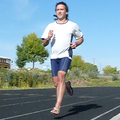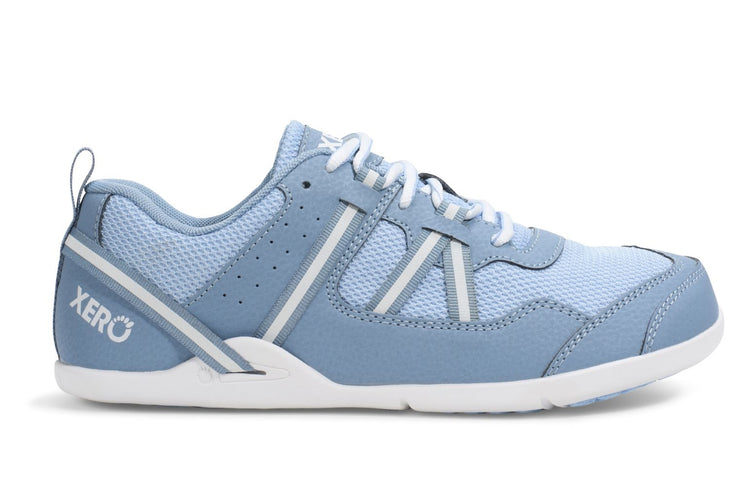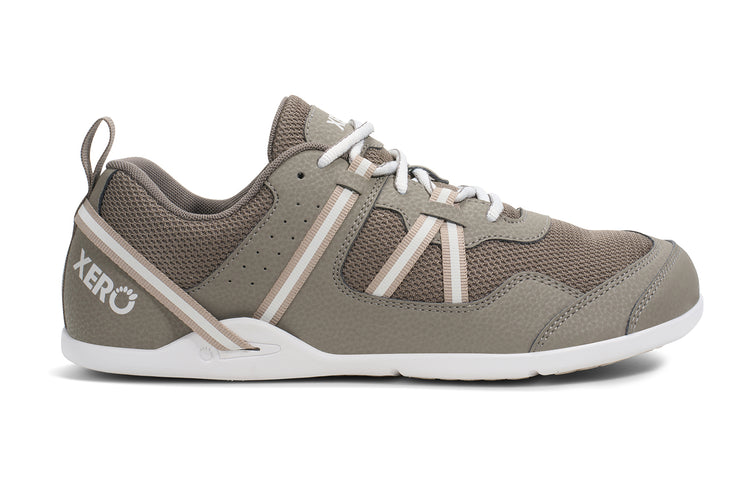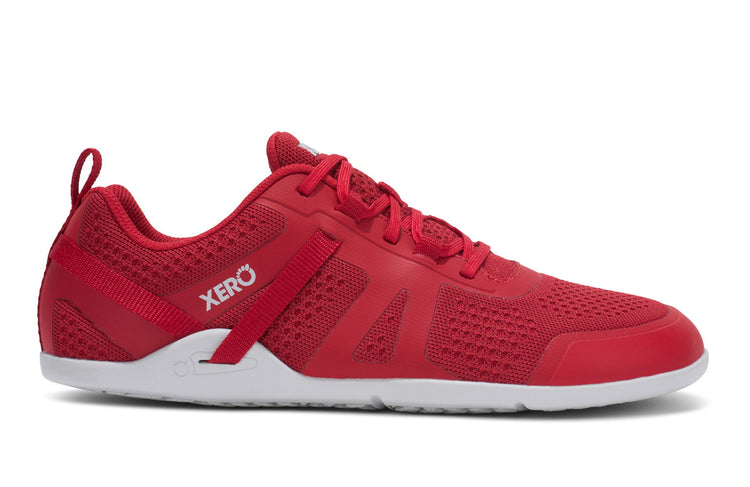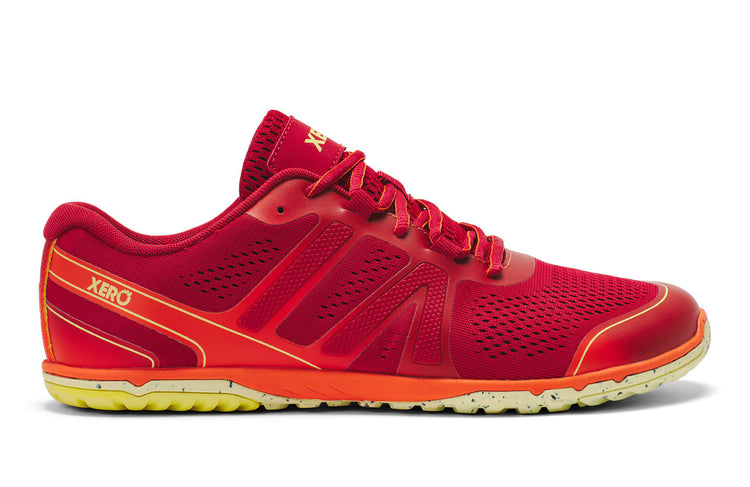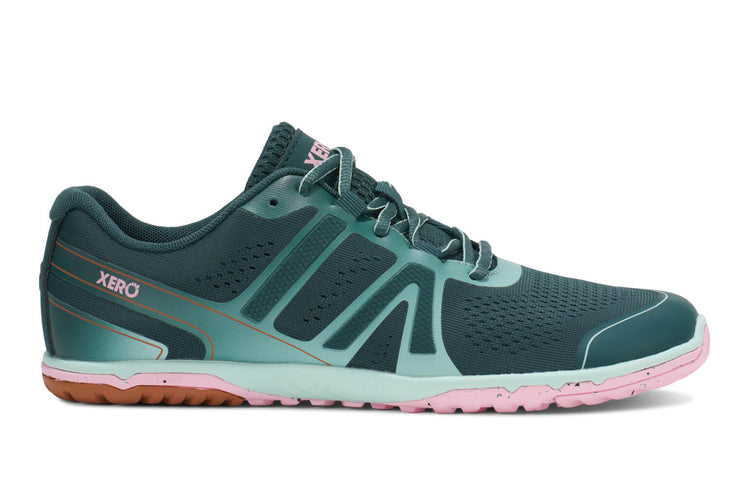latest News

Can You Cure Plantar Fasciitis with Barefoot Running?
A new study by Michael Rathleff and his colleagues offer a new approach for treating plantar fasciitis: strength training. More specifically working on foot and calf strength.Click here to read about the research. I can't say I'm surprised by this. It's often the case that gaining strength cures many movement-related problems. But what's most interesting to me is that this research suggests why many barefoot runners report an elimination of plantar fasciitis. Specifically, when you look at the report about the research and read the recommendations for the type of strength training to do, you'll see that the movements are very similar to what you do when you run with a forefoot or midfoot landing.Running this way "pre-loads" your plantar fascia, positioning your foot in a strong position when it contacts the ground, rather than being in the pre-streteched and weak position that you're in when you heel strike, especially in a highly padded shoe.The content of this post does not constitute and is not intended to be a substitute for professional medical advice, diagnosis or treatment. Always seek the advice of a physician or other qualified health provider with any questions or concerns you may have about your health or a medical condition.
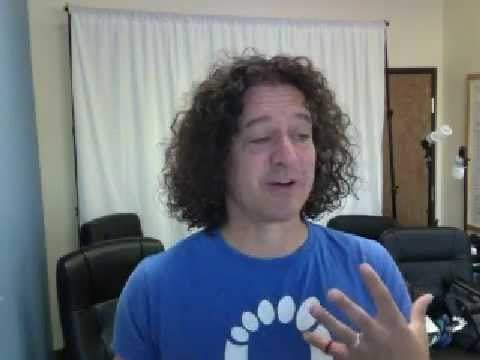
Barefoot Running Q&A - Transitioning, pain, and cold weather
Here's another Barefoot Running Q&A video, where I take an email I've received and give an answer on video.In this video we look at the relationship between barefoot and minimalist shoes, foot and calf pain during the transition to barefoot, how minimalist shoes fit in with the transition to bare feet, and how to handle the cold.Some of the links you'll want to take a look at:Transitioning to Barefoot RunningIs Calf Pain NecessaryDealing with "top of foot pain."Barefoot running and cold weather
Warning: Chia Seed Recall
There's been a national recall on some brands of Chia Seeds.This won't affect you if you think Chia Seeds are something you use to make "pets," but it might if you eat them.The affected brands include Organic Traditions, Williams-Sonoma, and Navitas Naturals brand chia and chia-flaxseed blend powders.Many of our readers heard about Chia from the book, Born To Run, which described it as one of the superfoods that the Tarahumara use to fuel themselves for epic runs. And you'll often find barefoot runners with a handful of seeds, or a gloopy-looking beverage full of chia.The Consumerist blog reported that many people are unaware of the recall of chia seeds, caused by the fact that certain chia brands are contaminated with salmonella and have sickened at least 65 people so far.So, barefoot runners, and everyone else who eats chia, please check your supplies, and not just the seeds that are still stuck in your teeth from last week's smoothie ;-)
Amuri Cloud Webinar
Have questions about the new Amuri Cloud, or any Xero Shoes product, or anything about barefoot running?Then join me on a live webinar where I'll answer 'em all.When: Thursday, March 27th at 6pm PT (that's 7pm Mountain time, 8pm Central time, 9pm Eastern).Where?Online -- Click Here to join us!
Do you need to call the Superheros of Health?
We take a break from our usual chat about barefoot running and walking for this:I don't think it's much of a confession to say that I'm a total health and fitness geek.I love keeping up on the research about strength training (most recently: power factor training), diet (my latest obsession: resistant starch), supplementation (lately: nothing), and anything else that could improve the quality of my life.So, I was a kid in a candy store when I heard about "The Superheroes of Health"Amber Rogers, from gokaleo.com has put together an incredible collection of 23 ebooks and audios that dig behind the mythology of health and fitness. Some of my favorite writers/researchers are in the mix. In fact, I already owned 3 of the ebooks in the Superheroes of Health collection. But that didn't stop me from buying the whole package ;-)I hope that you get introduced to some great people, including Armi Legge, Chris Highcock, Alan Aragon, Amber Rogers, and a LOT more. And, more, I hope yu get some great value out of the info that Amber has put together for you.And now, back to our regular barefoot running shoes programming ;-)
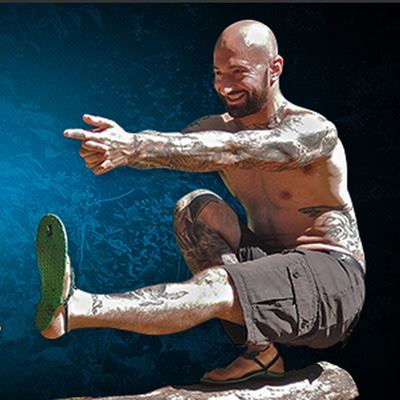
Fitness Guru Al Kavadlo chats with Xero Shoes
I met (online) Al Kavadlo over 3 years ago and was really impressed with what he was teaching and how well he practiced what he preached. Al has been a big fan of Xero Shoes, sending us photos of him running through the streets of New York, across the Brooklyn Bridge, and performing all manner of impressive bodyweight exercises in his Xeros. Al is a master of body weight training and has put together some of the best coaching I've seen on that topic... something that we both agree every runner could benefit from. We got together thanks to Google Hangouts to have a chat. We didn't have an agenda, and didn't prepare anything in advance, and I'm sure you'll enjoy watching this conversation with Al that includes: Strength training without equipment Best strengthening exercises for runners The link between barefoot running and bodyweight exercise Can you go barefoot in New York? REALLY? A new way to bring fun -- and fitness -- into your running ... and a lot more Let us know what you think in the comments below. And check out Al's fitness products: Pushing The Limits -- one of the best books on the essential bodyweight exercises I've ever seen. Great photos, and not just because so many of them feature Xero Shoes! Raising The Bar -- everything you can do with a pull-up bar (it's a LOT). If you're more visual, then check out the Raising the Bar DVD. Progressive Calisthenics Workshop -- based on the principles in Convict Conditioning, a classic in the bodyweight strength game.
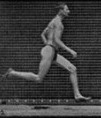
Become your own barefoot running coach
I had an intense sprinting workout 2 days ago, followed by an even more intense weight lifting workout and this morning I can barely walk. Even more, I did a minor tweak of something in my ankle which I'm noticing as I walk on my treadmill (I have a treadmill desk). As I'm walking, I have to experiment and make minor changes to my gait in order to walk with proper form and pain free.This reminded me of an old joke:"Doctor, it hurts when I do this.""Well, stop doing that!"While this is an old joke, it's important barefoot running lesson, namely:If it hurts, STOP DOING THAT.Remove the following thought from your mindFor decades now we've been told things like "No pain, no gain" (I'm assuming you remember the running shoe company that first told you that).(BTW, I'm no conspiracy theorist, but if I sold a product that contributed to injuries the way that running shoes seem to, I can't think of a better way to convince people to use my product, despite the effects they may have been experiencing when using it.)But, back to the point... When it comes to barefoot running (and walking, and hiking, and anything else), the most important skill you can develop is the ability to be your own coach. And the most important coaching skill you can learn is to experiment with different movement patterns.When it comes to running barefoot, the odds are high that if you're doing something that hurts you're doing something incorrectly. And the way to make things stop hurting is to do something differently.Becoming your own barefoot running coachWhat are some of the kinds of hurts I'm talking about? Sore calves Sore Achilles (sore anything, really) Blisters Callouses Stubbed toes Abrasion between your toes, on top of your foot, or around your heel (if you're wearing huaraches). If you're wearing huaraches running sandals, there are some "injuries" to the sandals that "hurt", like: Wearing away the toe knot Breaking the toe strap above the knot Breaking the strap by the outside ankle hole All of these can be corrected by doing something differently, by changing your gait, or your thinking.What kind of changes are we talking about? Don't reach out with your foot (overstriding), but place your foot under your body as much as possible. For some people, you'll want to try to have your feet land behind you (you won't be able to, but the cue will move your feet further back). Barefoot Ken Bob has a great line: Move your torso forward and have your feet try to catch up. Another tip for doing something different than overstriding: pull your toes up towards your knees slightly, just before you land... some people overstride by reaching out with their toes. Don't push off the ground with your toes/calves, but LIFT your foot off the ground by flexing the hip. Don't think of your foot as something you "land" on, but as something that skims across the ground at the speed you're moving. Try a different surface -- smooth hard surfaces are the best for barefoot running because they give you the most feedback about your form. But if you're on a surface that hurts to run on, try a different one. Do shorter runs. Give yourself as much time as YOU need to learn proper barefoot technique. There's no magic number of days or weeks that it'll take. It's different for everyone. Start with short runs, really short runs... like 200 yards. Pick up your cadence. Move your feet faster, without running faster. Experiment with different speeds. Some people say you MUST run at 180 steps per minute. It's not true; that's not a magic number. But the odds are good that you'll want faster turnover than you're used to. In the cold, do "loops" instead of runs. Your body can handle cold better than you think, especially if, instead of doing one long run, you go out until your feet are cold, come back and warm up, and repeat. Try landing on your feet in different ways. You're not required to land on the ball of your foot. Midfoot might work better for you. Flat footed might work better. How you land when you're going uphill may be different than downhill. Fast may be different than slow. Many of these are overlapping. If you don't overstride, you won't have to pull your foot toward you. If you speed up your cadence, it's harder to overstride and harder to use your calves too much.Do the mathMany of the problems described above are related to these equations:Excessive friction causes abrasion. Abrasion causes blisters or lace wear. Excessive friction is unnecessary for running barefoot.Using muscles more than necessary causes soreness. You can run barefoot with less muscle tension than you think.If you look at the feet of accomplished barefoot runners, you won't find blisters or callouses. If you look at the bottoms of the sandals of accomplished barefoot sandal wearing runners, you'll find no abrasion on the toe knot or the ankle hole areas.If you tested barefoot runners for calf strength, they're typically not any stronger than the average non-barefoot runner.Did I mention: Have Fun!Perhaps this is the most important coaching tip you can give yourselfIf you're not having fun, do something different until you are! Run like a 3 year old for a while: let your head lead you, let your arms flail, run in circles and sweeping arcs, make noise!I often have this thought going through my head as I run: "What can I do to make this lighter, easier, and more fun?" Give it a whirl.Good to greatA good coach can give you a workout to follow.A great coach will adjust the workout, moment by moment, based on reality.Feeling good? That'll change things.Feeling tired? That'll change things.Different location, elevation, weather? That'll change things.Let yourself become a great barefoot running coach.And let us know how it goes! Quick update: The evening after writing this post, Lena asked me, "How's your ankle?""What do you mean?" I replied."You wrote a post that said you tweaked your ankle.""Oh, right," I said, remembering. "After an hour of experimenting with how I was walking on the treadmill, it must have fixed itself, because it's fine now."The content of this post does not constitute and is not intended to be a substitute for professional medical advice, diagnosis or treatment. Always seek the advice of a physician or other qualified health provider with any questions or concerns you may have about your health or a medical condition.
Barefoot Training Teleseminar
Last night (November 25th, 2012), we had a teleseminar about all things barefoot, from running to walking to hiking to, well anything else that came up. It was an open format call where I just answered whatever questions came up. We discussed: Distance running form vs. sprinting form The proper way to walk when barefoot "Front side" vs. "Back side" mechanics Which muscles you should be using when you're barefoot/minimalist Confusion about foot strike (and clarification about what's correct) Barefoot running injuries and what's the best kind of injury you can get (seriously) Why comparing sole thicknesses of minimalist shoes is meaningless What makes Xero Shoes different than other minimalist footwear, including other sandals and a LOT more... The call ran about 42 minutes and, no doubt, we'll be doing more of them in the future. It was a lot of fun. You can listen to the teleseminar by clicking here: Barefoot Teleseminar If there's a question we didn't get to, feel free to ask it in the comments section. I may answer it here, or I may wait and schedule another barefoot teleseminar and dive into it on the call.Likewise, you can reach out to us directly through our support box, or phone line. The content of this post does not constitute and is not intended to be a substitute for professional medical advice, diagnosis or treatment. Always seek the advice of a physician or other qualified health provider with any questions or concerns you may have about your health or a medical condition.
Why barefoot sandals and not minimalist shoes?
New to "barefoot shoes"? Trying to decide between the minimalist shoe options?I know the feeling. Back in 2009, when I knew I wanted the benefits of being barefoot, but with a bit of protection (and something that would let me get into restaurants), I tried everything.I LOVE our new minimalist shoes... they're built off of our sandal base so they're as close to barefoot as any shoe I've ever tried.That said, if you want a "more barefoot" experience, you'll want to try a sandal at some time. Here's why. Better Bare Foot Feel -- You want to feel the ground as much as possible, without having to worry about what you're stepping on. With our FeelTrue® outsoles, you get the closest thing to a barefoot feel, but with the protection you want. BTW, don't be fooled by some shoe companies that claim to have a 4mm or 6mm outsole. If the sole is stiffer, it'll reduce the ground-feel. And if they add any padding on the inside of the shoe, that contributes to the thickness. Natural Movement-- You want to let your feet move and your toes flex and wiggle without anything getting in the way. With the dual-direction chevron treads and the flexibility of our FeelTrue® rubber, our outsoles let you grip the ground. And with nothing restricting the top of your foot, your toes can lift and splay as much as you want. Anti-bacterial/Anti-Odor -- The air circulates around your foot, instead of having your feet wrapped up. Easier Fit -- Our sandals will fit your foot, no matter what shape it is -- curved, straight, narrow, wide. And you can trim some of them with a pair of kitchen scissors for a perfect fit. Lightweight -- At 3.4 ounces for a men's size 9 (the 4mm DIY kit), you'll have a hard time finding anything that feels like, well, you're almost barefoot. We've had customers forget they were wearing their Xero Shoes and go to bed with them still on! Multi-purpose -- People all around the world use Xero Shoes for everything from walking, to hiking, to camping, to yoga, to stand-up paddleboarding, to sea kayaking, to sky-diving, to running, to tackling 100-mile ultra-marathons! Convenient -- Xeros roll or fold and fit in small spaces. Stick 'em in your pocket so you have them handy for a hike or to get through the airport faster. Personal Style -- With 5 different sole colors, dozens of lacing styles, and even more decorative add-ons, you can have sandals that are high-performance, ultra-minimalist or fashion-forward and ready for a night on the town. In fact, those could be the same pair! Inexpensive -- I don't get how minimalist shoes and sandals can be $150-$200! Ours are under $80. Xero Shoes' sandals are a fraction of that price. You could get 5 pairs (one in each color! ;-) of our DIY kits for the price of some minimal running shoes. Long-Lasting -- People often ask how long Xero Shoes will last. True to our tire-sandal heritage, Xero Shoes come with a 5,000 mile sole warranty. Compare that to running shoes that you're supposed to replace every 300-500 miles!
Dr. Mark's brilliant Natural Running video
Dr. Mark Cucuzzella is not only FAST (he won the US Air Force Marathon this year), he's committed to understanding the facts of barefoot running (and minimalist, too).As a physician, professor, and owner of Two Rivers Treads running shoe store, Mark is all about getting people running safely, enjoyably, and easily. Plus, he's a really nice guy.Mark just released an incredible video about "Natural Running." His emphasis in the video is about running barefoot, but his point is that if you run with a natural gait, you may be fine in a minimialist running shoe, too.Check out this video and let me know what you think.One of my favorite parts is simply seeing mark run... FAST. There are so many critics who say "You never see barefoot runners who have any speed" (forgetting, of course, Abebe Bikila, Zola Budd, Ron Hill, and many other fast, barefoot Olympians).I also like how Mark doesn't emphasize exactly how your foot is supposed to hit the ground other than "don't heel strike." A number of us, including Mark and Pete Larson (of www.runblogger.com) have been saying, "There will be individual differences in how you land on your foot -- from flat-footed, to fore-foot -- that will depend on your physiology and biomechanics as well as how fast you're running and whether you're running uphill, downhill, and even on the surface."That said, most new runners may want to focus on a forefoot strike at first, if for no other reason than many of us have lost our proprioceptive skills from years of wearing shoes and may think we're mid- or fore-foot landing when we're still heel striking. I've had more than my share of runners try to convince me that their heels never touched the ground, even when looking at video showing them clearly heel striking.Thanks to Mark for this great addition to the world of barefoot and natural running.The content of this post does not constitute and is not intended to be a substitute for professional medical advice, diagnosis or treatment. Always seek the advice of a physician or other qualified health provider with any questions or concerns you may have about your health or a medical condition.
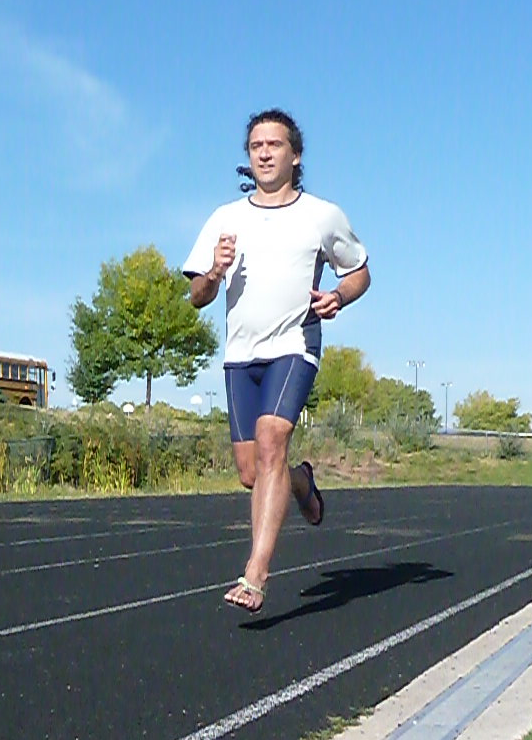
How To Run Barefoot
How to Run Barefoot: Techniques to Get Started “How do I start barefoot running?” “What’s the best book/course/coach for learning to run barefoot?” “Can you show me what the best barefoot running form looks like?” I get these questions a lot. And it’s a bit tricky to answer them for a few reasons: Frankly, if all you did was take off your shoes, go for a run, stop when it hurts, and experiment to find ways of running that feel light, easy and fun (which is the way running with natural form should feel), you would learn more than I, or anyone else, could tell you. Those of us who’ve observed barefoot runners and coached barefoot running are starting to notice the obvious: different runners have slightly different form. That is, when you look at the BEST runners, they have many things in common, but they’re not all doing the exact same thing. So, I don’t want to say something that isn’t going to be relevant for YOU. To be totally candid, I’m in an awkward political situation — as a guy who sells “barefoot-style” footwear, and who would like to have ALL the coaches referring their clients to me, I can’t single out one coach/book/technique over another (or one “under” another, either). I can tell you that if you listen to ALL of them, and then follow a bit of advice I’ll give, below, you’ll appreciate each coach for his/her unique contribution to your barefoot running form. Many runners aren’t aware of what their bodies are actually doing, so certain recommendations won’t be effective anyway. If I say to you, “don’t land on your heels,” and show you a video of how you’re “supposed” to land on your foot, you may be 100% convinced that you’re doing what I suggested, and then a video might show that you are totally heel-striking. In other words, what I say will be less important than what you learn on your own. However, what I CAN do is offer some thoughts about getting started with barefoot running. Tips on How to Run Barefoot Here are my best tips on how to get started running barefoot, refining your running technique, and enjoying the benefits and fun of barefoot running How to Getting Started Realize that the best coach you have is YOU and your sensations and whatever you can learn from watching video of yourself (especially slow motion video). In fact, you MUST become your own best coach, because no external coach will be there for every situation you’ll encounter as a runner. If you can’t listen to yourself, make adjustments in what you’re doing, and know when to STOP… no other coach will be helpful anyway. Start SLOWLY and build up. There’s no rush in making the transition to barefoot running. And there’s no way to predict how long it will take YOU. Run barefoot on a hard, smooth surface. These surfaces are best for learning because they give you the most feedback. Remember that barefoot running is a never-ending process. You can always improve. Refining Your Barefoot Running Form To be slightly more specific and technical, and tell you some of what you would discover on your own with enough time and attention: Aim for having your feet land “under your body” - more so than you’re probably used to. Landing with your foot out in front of you too much is “overstriding” and it’s one of the habits that most of us need to work to overcome. You may need to even exaggerate this to get the feel of it — put your feet “behind you” when you land. You won’t actually be able to do this, but if you try it will highlight what overstriding feels like… and the correct place to put your feet is probably somewhere in between. You want to land forefoot or midfoot. Do NOT reach out with your foot to do this; that’s the opposite of what you want to do. By the way, If you land with your foot underneath your body it's almost impossible not to land on your forefoot or midfoot. You don’t need to stay on the balls of your feet and put extra strain on your calves and Achilles tendons. Once you land on the ball/midfoot, you can let your heel drop if it feels better to do that, and it will feel better/worse depending on whether you’re going uphill or downhill or on a flat surface, and depending on what speed you’re running. Don’t PULL your foot toward you, or PUSH it behind you… that’ll cause blisters as well as put extra strain on your hamstrings (pulling) and calves (pushing). Think, instead, about PLACING your foot on the ground and LIFTING it off. And lift by using your hip flexor. That is, think about lifting your foot off the ground by lifting up your knee, not by pushing off the ground. Un-Plop your feet. This is hard to describe, but many of us slam our feet into the ground, or wait for the ground to hit our feet. We plop them onto the ground instead of meeting the ground lightly. There are a lot of “cues” coaches use to teach this: Pretend you’re running on hot coals, or on thin ice, or trying to sneak up on a deer, or that your feet are wheels and you want them to touch where the wheel meets the ground, or that the ground is moving below you like a treadmill and you want to move your feet at the same speed as the treadmill. You will need to find your own way to feel this. Keep your core tight… when you run, your body is a spring. If you collapse in your midsection, you’re weakening the spring and making it less efficient and, therefore, making it harder to run. Pick up your cadence. Most people think 180 steps-per-minute is some magic number. It’s not. Some successful runners do more, some do less. The point of moving your feet faster than you’re probably used to is that it gives you less time to keep your feet on the ground… and that’ll help you learn to place/lift, “un-plop” and not overstride. LISTEN to the sound your feet are making… if you’re running loudly, if you make a lot of noise when your feet hit the ground, you’re doing one of the above incorrectly. This is true if you’re barefoot, in our barefoot shoes, or any other footwear. You can run quietly (not silently), and quiet running is usually a sign of good form. WONDER! When I run, I keep a question in my mind, “How can I make this lighter, easier, and more fun… and, sometimes, faster?” Then, I experiment and see what I can find. Finally, and most importantly: REST. Bodies get stronger when you let them rest. There are no bonus points for not taking a day off. HAVE FUN! If it’s not fun, do something different. Try a different surface, a different speed, a different reason for running (compete if you haven’t before, do an obstacle course if you’re usually all about putting in mile after mile). I’m sure other barefoot runners have additional pointers. Can’t wait to hear them. Oh, and did I mention, barefoot running can be, should be, and IS (once you get it) FUN… don’t forget that! Want to learn more about learning how to barefoot running? Watch this video below The content of this post does not constitute and is not intended to be a substitute for professional medical advice, diagnosis or treatment. Always seek the advice of a physician or other qualified health provider with any questions or concerns you may have about your health or a medical condition.
Getting started with barefoot running
Imagine that you haven't lifted weights in a while... or ever.And imagine that you got the idea that you wanted to bench press 500 pounds.Would you go to the gym, put 500 pounds on the bar, and just go for it?Of course not. There's no way you could budge 500 on day one.Would you go to the gym and put, say, 100 pounds on the bar and lift it, over and over, until you felt tired... and then do a few more reps until you were wasted?I hope not.Would you take a small weight, like 20 pounds, and lift it for an hour or two?Boy, I wouldn't.But for some reason people think they can get into barefoot running with one of those plans.They think they can just whip off their shoes and replace one of their regular runs with a barefoot run. Or, worse, they think that even if they haven't run for a decade, it'll be fine to go for a 5 mile barefoot run. Or they get out for a barefoot run, feel some strain or pain in their feet or calves and think, "Oh, I'll just work through this, it'll be fine."And they pay the price.They wake up with freakishly sore calves or Achilles tendons. They get blisters. They get plantar faciitis. They get stress fractures.Look, over-training is over-training. Doing too much is doing too much.Especially with barefoot running, TAKE YOUR TIME. There's no rush to get to the point where you're running an ultramarathon every day for 1000 days in your bare feet. And there's no way to rush building up the strength in your muscles and ligaments and tendons, or to develop correct and efficient form.It happens as it happens. No sooner, no later.How long that'll be is a mystery. Maybe it only takes you a week or a month. Maybe it takes you a year.Who cares?First of all, it's not all-or-nothing. It's not like you won't be able to be barefoot and then, BAM, 6 months from now you can! It's a process. Maybe today you can only run 100 yards and then need to ice your feet for 3 days. That's fine. In a month, guaranteed, you'll be doing more. And a month after that, you'll be doing even more.Secondly, nobody is telling you to throw away your shoes the moment you realize you want to become a barefoot runner. Keep your shoes. Enjoy your shoes. And look forward to when you don't want or need them.But, please, give yourself time -- the amount of time that YOU need -- to make the transition.Honestly, there's enough to learn and experience and benefit from if all you ever do is an occasional 1 minute jog without shoes.I hate to toss out "prescriptions for living," but in this case I can't think of any better way to say it than, "Enjoy the journey... because there isn't really a goal."The content of this post does not constitute and is not intended to be a substitute for professional medical advice, diagnosis or treatment. Always seek the advice of a physician or other qualified health provider with any questions or concerns you may have about your health or a medical condition." to the bottom of the blog post.The content of this post does not constitute and is not intended to be a substitute for professional medical advice, diagnosis or treatment. Always seek the advice of a physician or other qualified health provider with any questions or concerns you may have about your health or a medical condition.


